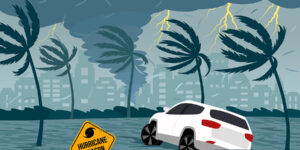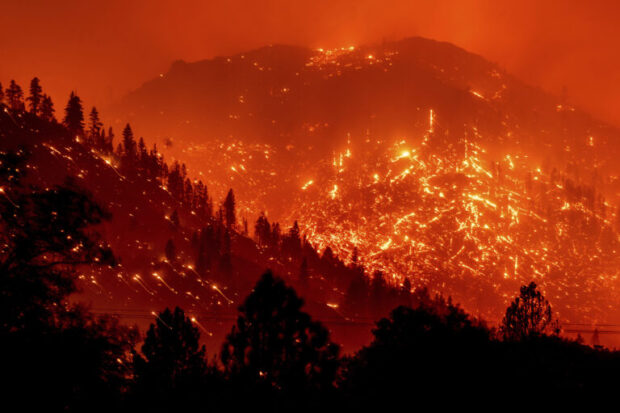The 2021 California wildfire season continued the worrying trend of more extreme fires than the historical norm. As of December 12, 8,786 wildfires had destroyed over 2.5 million acres, about 1 million more acres than the five-year average, according to Cal Fire.
Persistent drought, excessive heat, and ineffective forest management policies are among the factors contributing to larger and more destructive fires. Considering attributes such as intensity, severity, and rate of spread, some experts characterize the behavior of 2021 fires as “extreme,” “unpredictable,” and “unprecedented.”
Homeowners insurance carriers have responded by reducing coverage and raising premiums. When regulation permits, carriers have canceled or not renewed policies in the areas most susceptible to wildfire. As a result, California homeowners are facing an insurance availability and affordability crisis. Many have been forced into the California FAIR Plan, which offers basic protection and capped coverages. (Editor’s Note: The number of California homeowners nonrenewed by insurers actually fell by 10 percent statewide in 2020 compared with 2019, previous year, as according to a December report by the California Department of Insurance, which also showed that the number of policies written by the FAIR Plan rose for the second year to a new high. Mandatory moratoriums by Insurance Commissioner Ricardo Lara helped curb many of the nonrenewals.)
Despite taking steps to reduce exposure, most California insurers remain at risk for adverse underwriting results due to wildfire losses. Short of leaving the state entirely, homeowners insurers cannot avoid wildfire claims. California Senate Bill 824 (2018) imposes a mandatory one-year moratorium on “canceling or non-renewing residential insurance policies in certain areas within or adjacent to a fire perimeter” following a declaration of a state of emergency by the Governor. Additionally, most insurers are unwilling to walk away from millions of dollars in homeowners insurance premiums, even in vulnerable areas. Instead, many choose to selectively write wildfire-exposed properties, but with increased deductibles and substantially higher premiums.
The situation has been “lose/lose” for both carriers and policyholders. Insurers shed business and raised premiums, contributing to a critical lack of affordable insurance coverage for many California residents. At the same time, many insurers continued to lose money on wildfire-exposed business.
Many carriers struggle to adapt their risk selection criteria and pricing methodologies to respond to the changing wildfire risk landscape. Some continue to rely on underwriting rules and models based on outdated assumptions, methods, and criteria that do not fully reflect current conditions or the latest research in wildfire behavior. As a result, many insurers do not have a firm grasp on their California homeowners wildfire exposure.
Underwriting In A Dynamic Risk Landscape
Conventional approaches to underwriting wildfire have proven ineffective in an environment where recurring heatwaves, prolonged droughts, changing precipitation patterns, and other factors are altering the risk landscape. Assumptions about fuel sources, access, and other variables which were the foundation for sound underwriting decisions in the past may be less relevant under the specific conditions that characterize recent fires. For example, larger fires that spread rapidly through airborne embers have become more common under current conditions. Traditional approaches to underwriting that rely substantially on analyzing vegetation patterns are not adequate for fires that grow quickly and in less predictable ways because of burning embers scattered widely by the wind.
The drought, heatwaves, and other extreme conditions experienced in 2020 and 2021 may be a harbinger of the future, and demand new approaches to underwriting and pricing wildfire insurance coverage. Digital tools built on machine learning algorithms, new data sources such as multi-spectral satellite imagery, and the input of climate scientists and fire experts have proven especially effective in analyzing wildfire risk. These computer models can quantify wildfire susceptibility, likelihood, and intensity under a wide range of actual and hypothetical scenarios, even amid rapidly changing conditions. This leads to more dependable data-driven underwriting, pricing, and portfolio management decisions.
A New Underwriting Paradigm
Machine learning algorithms can identify subtle and non-intuitive relationships among variables within large and complex data sets. One of the most powerful examples of this is finding how combinations of conditions impact how input variables should be weighted dynamically, vs. a one-size-fits-all approach. They also can adjust to changes in inputs and outcomes over time. Using satellite images and other exposure data, machine learning algorithms augmented with the in-depth knowledge of climate scientists and wildfire experts can identify and quantify relationships among factors such as vegetation condition, ignition sources, weather, terrain, and individual and community mitigation measures.
With advanced models, underwriters can benefit from better market segmentation and more accurate individual risk selection. Characteristics that determine a particular property’s susceptibility to wildfire can be identified and quantified, enabling underwriters to differentiate properties on a location-by-location basis. Carriers can spot the better risks within their existing portfolios and price them accordingly. On a larger scale, profitable bands of risk can be detected within otherwise highly exposed areas, allowing insurers to identify growth opportunities within territories largely written off by carriers with less effective underwriting and pricing tools.
More precise underwriting and pricing tools will benefit insurers and can help relieve some of the availability and affordability issues experienced by many California homeowners. These tools can help carriers achieve growth and profitability goals by preserving in-force business that might have been lost to broad-brush reactions to underwriting losses and by selectively writing new business in areas that other insurers have largely abandoned.
Superior data and analytics also should give reinsurance companies confidence in the ability of their ceding companies to profitably underwrite in wildfire-distressed territories, increasing their comfort with providing capacity for California homeowners business. These same tools also can help both insurers and reinsurers to better manage their catastrophe accumulations—to understand and control how much is at risk from any one large fire event or an aggregation of smaller events.
It’s unlikely that the wildfire environment will materially improve in the near term. The level of destruction will vary from year to year, but climate trends all but assure that wildfire will be an increasingly serious risk for homeowners throughout California. Individuals and communities can do more to mitigate fire risk, and changes in forest management practices will likely have a positive longer-term impact, but the relentless heat and drought that produce dangerous conditions are likely to continue.
Effective wildfire risk modeling requires robust data and advanced analytics supported by deep expertise in the factors driving wildfire spread and destruction. The winners in the California homeowners insurance market will be those who understand how to leverage new technologies and data to thrive under challenging conditions now and in the future.
(AP Photo/Noah Berger: Dixie Wildfires Burning in California)





















 Active Workstations May Improve Cognitive Performance: Study
Active Workstations May Improve Cognitive Performance: Study  That Insurance Talent Crisis? It’s a Global Knowledge Opportunity
That Insurance Talent Crisis? It’s a Global Knowledge Opportunity  AI-Powered Insurance Product Development Is Going to Take Some Powering Through
AI-Powered Insurance Product Development Is Going to Take Some Powering Through  Viewpoint: You’re at a Competitive Disadvantage If You’re Not Innovating
Viewpoint: You’re at a Competitive Disadvantage If You’re Not Innovating 




